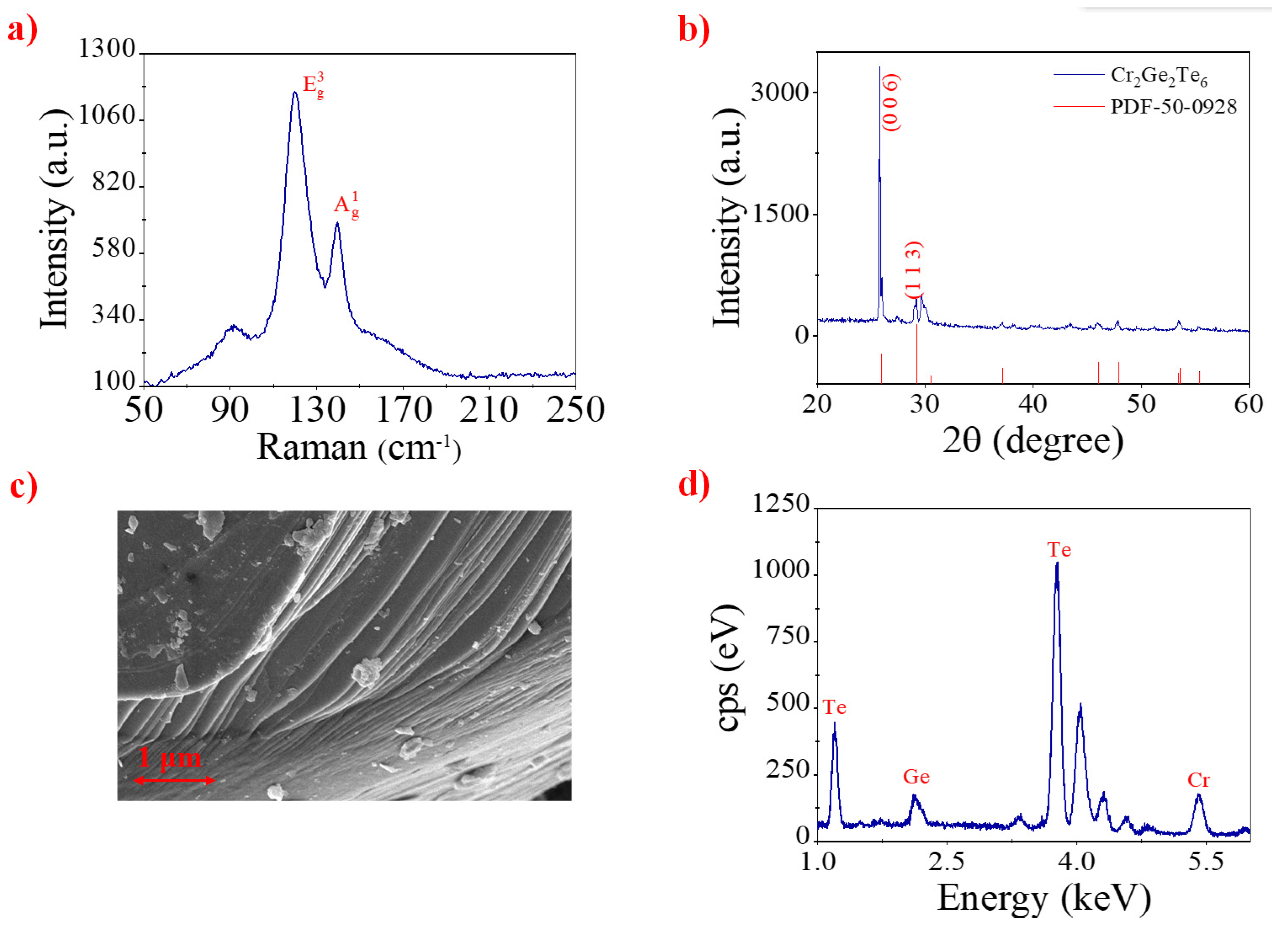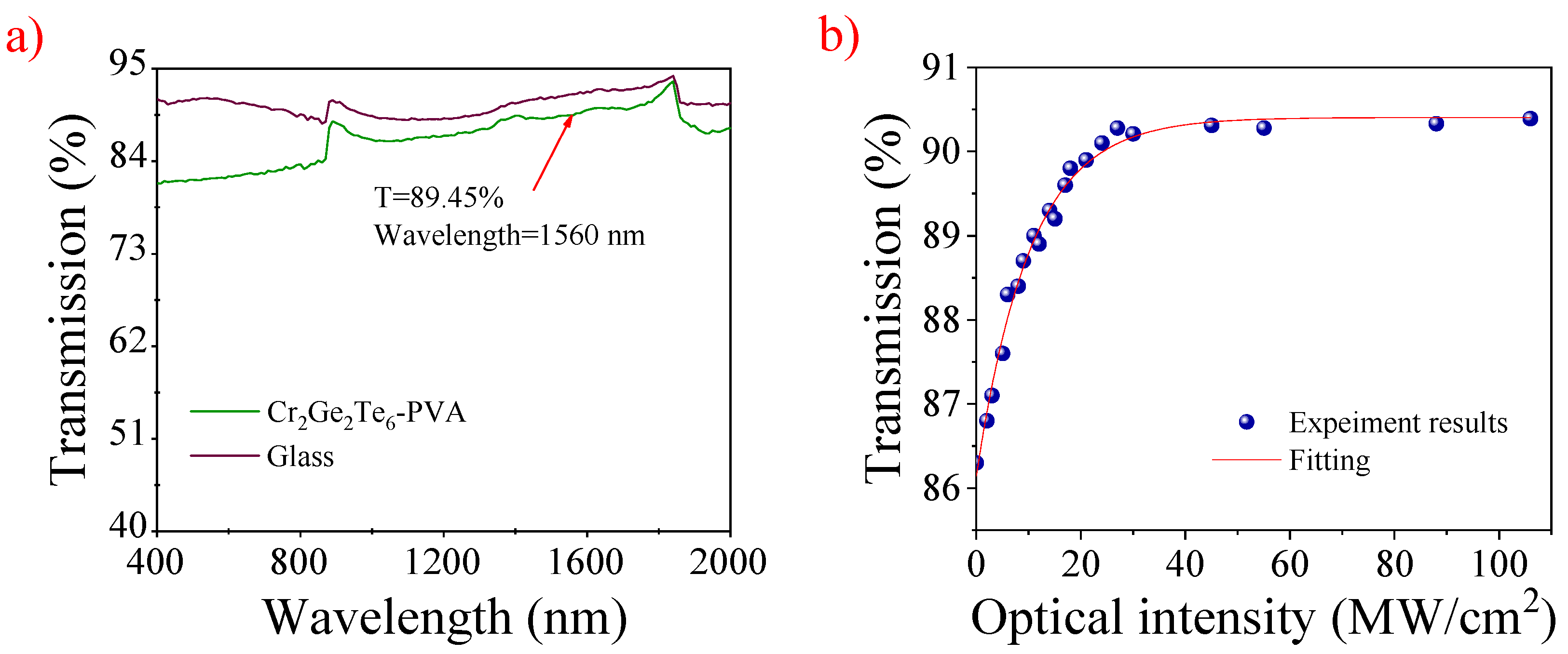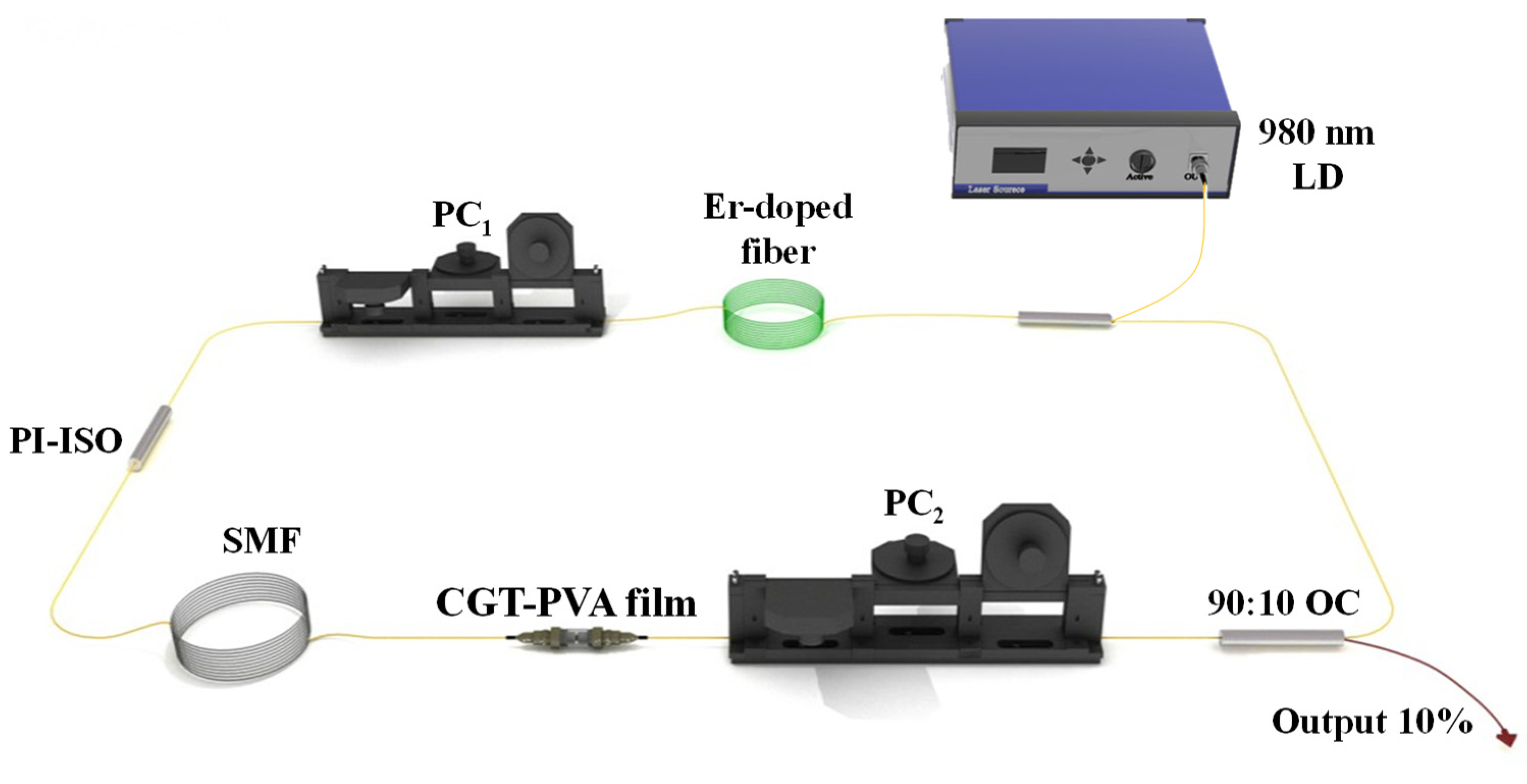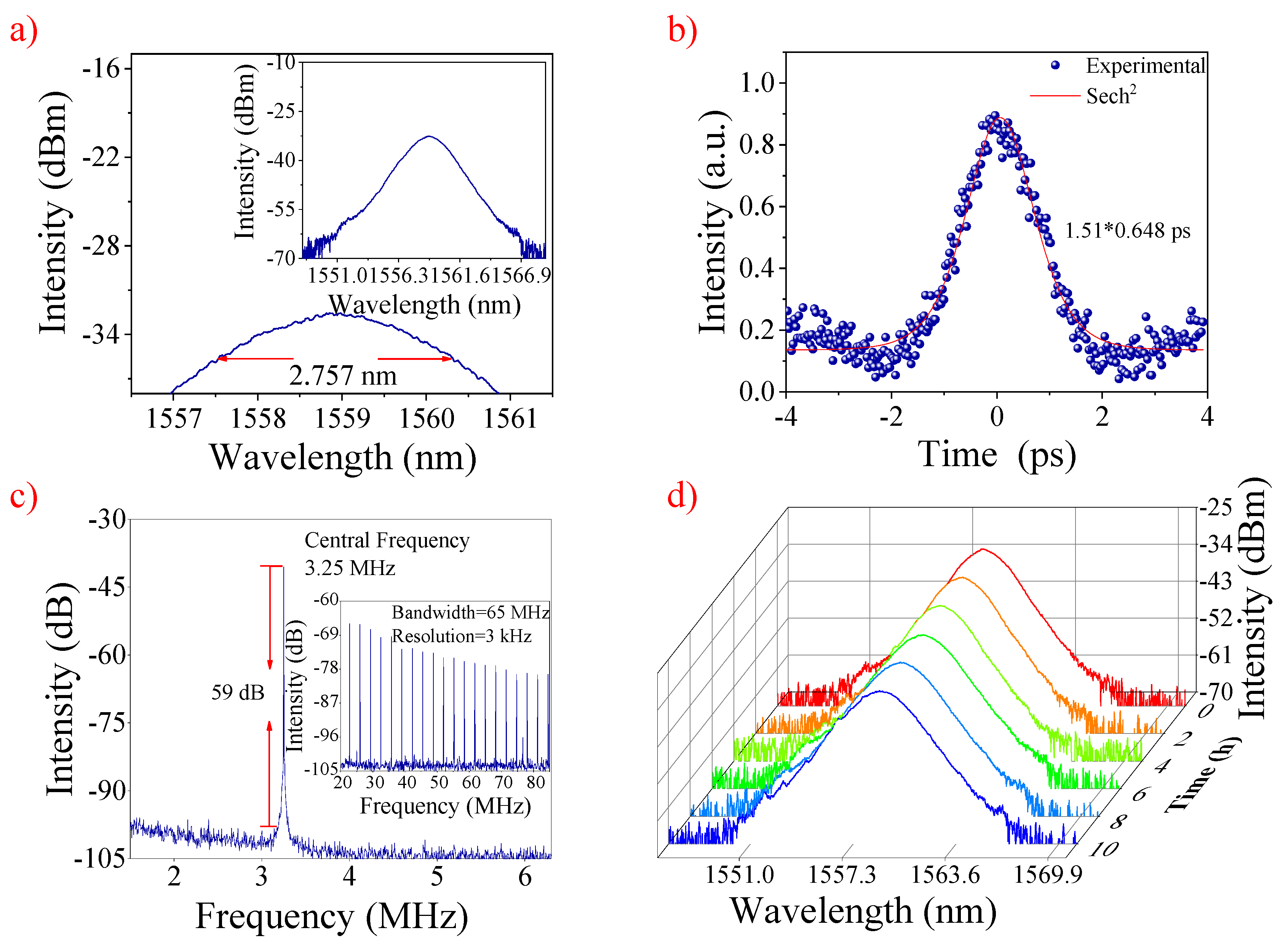Efficient Saturable Absorber Based on Ferromagnetic Insulator Cr2Ge2Te6 in Er-Doped Mode-Locked Fiber Laser
Abstract
:1. Introduction
2. Preparation and Characterization of the CGT SA
2.1. Preparation of CGT-Based SA
2.2. Characterization of CGT SA
3. Experimental Results and Discussion
4. Conclusions
Author Contributions
Funding
Institutional Review Board Statement
Informed Consent Statement
Data Availability Statement
Conflicts of Interest
References
- Koppens, F.H.L.; Mueller, T.; Avouris, P.H.; Ferrari, A.C.; Vitiello, M.S.; Polini, M. Photodetectors based on graphene, other two-dimensional materials and hybrid systems. Nat. Nanotechnol. 2014, 9, 780. [Google Scholar] [CrossRef] [PubMed]
- Sun, Z.H.; Chang, H.X. Graphene and graphene-like two-dimensional materials in photodetection: Mechanisms and methodology. ACS Nano 2014, 8, 4133–4156. [Google Scholar] [CrossRef] [PubMed]
- Liu, Y.X.; Dong, X.C.; Chen, P. Biological and chemical sensors based on graphene materials. Chem. Soc. Rev. 2012, 41, 2283–2307. [Google Scholar] [CrossRef] [PubMed]
- Jiang, H.J. Chemical preparation of graphene-based nanomaterials and their applications in chemical and biological sensors. Small 2011, 7, 2413–2427. [Google Scholar] [CrossRef] [PubMed]
- Tongay, S.; Zhou, J.; Ataca, C.; Liu, J.; Kang, J.S.; Matthews, T.S.; You, L.; Li, J.B.; Grossman, J.C.; Wu, J.Q. Broad-range modulation of light emission in two-dimensional semiconductors by molecular physisorption gating. Nano Lett. 2013, 13, 2831–2836. [Google Scholar] [CrossRef]
- Mueller, T.; Xia, F.N.; Avouris, P. Graphene photodetectors for high-speed optical communications. Nat. Photonics 2010, 4, 297. [Google Scholar] [CrossRef] [Green Version]
- Zhang, H.; Tang, D.Y.; Knize, R.J.; Zhao, L.M.; Bao, Q.L.; Loh, K.P. Graphene mode locked, wavelength-tunable, dissipative soliton fiber laser. Appl. Phys. Lett. 2010, 96, 111112. [Google Scholar] [CrossRef] [Green Version]
- Martinez, A.; Sun, Z.P. Nanotube and graphene saturable absorbers for fibre lasers. Nat. Photonics 2013, 7, 842. [Google Scholar] [CrossRef]
- Shang, X.X.; Guo, L.G.; Zhang, H.N.; Li, D.W.; Yue, Q.Y. Titanium Disulfide Based Saturable Absorber for Generating Passively Mode-Locked and Q-Switched Ultra-Fast Fiber Lasers. Nanomaterials 2020, 10, 1922. [Google Scholar] [CrossRef]
- Luo, Z.Q.; Wu, D.D.; Xu, B.; Xu, H.Y.; Cai, Z.P.; Peng, J.; Weng, J.; Xu, S.; Zhu, C.H.; Wang, F.Q.; et al. Two-dimensional material-based saturable absorbers: Towards compact visible-wavelength all-fiber pulsed lasers. Nanoscale 2016, 8, 1066–1072. [Google Scholar] [CrossRef] [Green Version]
- Xu, N.N.; Wang, H.F.; Zhang, H.N.; Guo, L.G.; Shang, X.X.; Jiang, S.Z.; Li, D.W. Palladium diselenide as a direct absorption saturable absorber for ultrafast mode-locked operations: From all anomalous dispersion to all normal dispersion. Nanophotonics 2020, 9, 4295–4306. [Google Scholar] [CrossRef]
- Wu, K.; Zhang, X.Y.; Wang, J.; Li, X.; Chen, J.P. WS2 as a saturable absorber for ultrafast photonic applications of mode-locked and Q-switched lasers. Opt. Express 2015, 23, 11453–11461. [Google Scholar] [CrossRef] [PubMed]
- Zhang, H.N.; Ma, P.F.; Zhu, M.X.; Zhang, W.F.; Wang, G.M.; Fu, S. Palladium selenide as a broadband saturable absorber for ultra-fast photonics. Nanophotonics 2020, 9, 2557–2567. [Google Scholar] [CrossRef] [Green Version]
- Niu, K.D.; Sun, R.Y.; Chen, Q.Y.; Man, B.Q.; Zhang, H.N. Passively mode-locked Er-doped fiber laser based on SnS2 nanosheets as a saturable absorber. Photonics Res. 2018, 6, 72–76. [Google Scholar] [CrossRef]
- Zhao, C.J.; Zou, Y.H.; Chen, Y.; Wang, Z.T.; Lu, S.B.; Zhang, H.; Wen, S.C.; Tang, D.Y. Wavelength-tunable picosecond soliton fiber laser with topological insulator: Bi2Se3 as a mode locker. Opt. Express 2012, 20, 27888–27895. [Google Scholar] [CrossRef]
- Liu, H.; Zheng, X.W.; Liu, M.; Zhao, N.; Luo, A.P.; Luo, Z.C.; Xu, W.C.; Zhang, H.; Zhao, C.J.; Wen, S.C. Femtosecond pulse generation from a topological insulator mode-locked fiber laser. Opt. Express 2014, 22, 6868–6873. [Google Scholar] [CrossRef] [Green Version]
- Sotor, J.; Sobon, G.; Abramski, K.M. Sub-130 fs mode-locked Er-doped fiber laser based on topological insulator. Opt. Express 2014, 22, 13244–13249. [Google Scholar] [CrossRef]
- Sotor, J.; Sobon, G.; Grodecki, K.; Abramski, K.M. Mode-locked erbium-doped fiber laser based on evanescent field interaction with Sb2Te3 topological insulator. Appl. Phys. Lett. 2014, 104, 251112. [Google Scholar] [CrossRef]
- Lin, Y.H.; Yang, C.Y.; Lin, S.F.; Tseng, W.H.; Bao, Q.L.; Wu, C.I.; Lin, G.R. Soliton compression of the erbium-doped fiber laser weakly started mode-locking by nanoscale p-type Bi2Te3 topological insulator particles. Laser Phys. Lett. 2014, 11, 055107. [Google Scholar] [CrossRef]
- Xu, N.N.; Ming, N.; Han, X.L.; Man, B.Y.; Zhang, H.N. Large-energy passively Q-switched Er-doped fiber laser based on CVD-Bi2Se3 as saturable absorber. Opt. Mater. Express 2019, 9, 373–383. [Google Scholar] [CrossRef]
- Chen, Y.; Jiang, G.B.; Chen, S.Q.; Guo, Z.N.; Yu, X.F.; Zhao, C.J.; Zhang, H.; Bao, Q.L.; Wen, S.C.; Tang, D.Y.; et al. Mechanically exfoliated black phosphorus as a new saturable absorber for both Q-switching and Mode-locking laser operation. Opt. Express 2015, 23, 12823–12833. [Google Scholar] [CrossRef] [Green Version]
- Sotor, J.; Sobon, G.; Kowalczyk, M.; Macherzynski, W.; Paletko, P.; Abramski, K.M. Ultrafast thulium-doped fiber laser mode locked with black phosphorus. Opt. Lett. 2015, 40, 3885–3888. [Google Scholar] [CrossRef]
- Luo, Z.C.; Liu, M.; Guo, Z.N.; Jiang, X.F.; Luo, A.P.; Zhao, C.J.; Yu, X.F.; Xu, W.C.; Zhang, H. Microfiber-based few-layer black phosphorus saturable absorber for ultra-fast fiber laser. Opt. Express 2015, 23, 20030–20039. [Google Scholar] [CrossRef]
- Mu, H.R.; Lin, S.H.; Wang, Z.C.; Xiao, S.; Li, P.F.; Chen, Y.; Zhang, H.; Bao, H.F.; Lau, S.P.; Pan, C.X.; et al. Black phosphorus–polymer composites for pulsed lasers. Adv. Opt. Mater. 2015, 3, 1447–1453. [Google Scholar] [CrossRef] [Green Version]
- Guo, B.; Wang, S.H.; Wu, Z.X.; Wang, Z.X.; Wang, D.H.; Huang, H.; Zhang, F.; Ge, Y.Q.; Zhang, H. Sub-200 fs soliton mode-locked fiber laser based on bismuthene saturable absorber. Opt. Express 2018, 26, 22750–22760. [Google Scholar] [CrossRef]
- Xu, N.N.; Ma, P.F.; Fu, S.G.; Shang, X.X.; Jiang, S.Z.; Wang, S.Y.; Li, D.W.; Zhang, H.N. Tellurene-based saturable absorber to demonstrate large-energy dissipative soliton and noise-like pulse generations. Nanophotonics 2020, 9, 2783–2795. [Google Scholar] [CrossRef] [Green Version]
- Chen, Z.D.; Wang, H.Y.; Wang, Y.G.; Lv, R.D.; Yang, X.G.; Wang, J.; Li, L.; Ren, W. Improved optical damage threshold graphene Oxide/SiO2 absorber fabricated by sol-gel technique for mode-locked erbium-doped fiber lasers. Carbon 2019, 144, 737–744. [Google Scholar] [CrossRef]
- Jiang, X.T.; Liu, S.X.; Liang, W.Y.; Luo, S.J.; He, Z.L.; Ge, Y.Q.; Wang, H.D.; Cao, R.; Zhang, F.; Wen, Q.; et al. Broadband nonlinear photonics in few-layer MXene Ti3C2Tx (T = F, O, or OH). Laser Photonics Rev. 2018, 12, 1700229. [Google Scholar] [CrossRef]
- Ming, N.; Tao, S.N.; Yang, W.Q.; Chen, Q.Y.; Sun, R.Y.; Wang, C.; Wang, S.Y.; Man, B.Y.; Zhang, H.N. Mode-locked Er-doped fiber laser based on PbS/CdS core/shell quantum dots as saturable absorber. Opt. Express 2018, 26, 9017–9026. [Google Scholar] [CrossRef]
- Fu, S.G.; Li, J.J.; Zhang, S.S.; Bai, Z.D.; Wu, T.G.; Man, Z.S. Large-energy mode-locked Er-doped fiber laser based on indium selenide as a modulator. Opt. Mater. Express 2019, 9, 2662–2671. [Google Scholar] [CrossRef]
- Koo, J.; Park, J.; Lee, J.; Jhon, Y.M.; Lee, J.H. Femtosecond harmonic mode-locking of a fiber laser at 3.27 GHz using a bulk-like, MoSe2-based saturable absorber. Opt. Express 2016, 24, 10575–10589. [Google Scholar] [CrossRef]
- Woodward, R.I.; Howe, R.C.T.; Hu, G.; Torrisi, F.; Zhang, M.; Hasan, T.; Kelleher, E.J.R. Few-layer MoS2 saturable absorbers for short-pulse laser technology: Current status and future perspectives. Photonics Res. 2015, 3, A30–A42. [Google Scholar] [CrossRef]
- Li, L.; Pang, L.; Wang, Y.; Liu, W. WxNb(1−x)Se2 nanosheets for ultrafast photonics. Nanoscale 2021, 13, 2511–2518. [Google Scholar] [CrossRef]
- Koo, J.; Jhon, Y.I.; Park, J.; Lee, J.; Jhon, Y.M.; Lee, J.H. Near-infrared saturable absorption of defective bulk-structured WTe2 for femtosecond laser mode-locking. Adv. Funct. Mater. 2016, 26, 7454–7461. [Google Scholar] [CrossRef]
- Pang, L.; Sun, Z.; Zhao, Q.; Wang, R.; Yuan, L.; Wu, R.; Liu, W. Ultrafast Photonics of Ternary RexNb(1–x) S2 in Fiber Lasers. ACS Appl. Mater. Interfaces 2021, 13, 28721–28728. [Google Scholar] [CrossRef]
- Liu, W.; Pang, L.; Han, H.; Bi, K.; Lei, M.; Wei, Z. Tungsten disulphide for ultrashort pulse generation in all-fiber lasers. Nanoscale 2017, 9, 5806–5811. [Google Scholar] [CrossRef]
- Mohanraj, J.; Velmurugan, V.; Sivabalan, S. Transition metal dichalcogenides based saturable absorbers for pulsed laser technology. Opt. Mater. 2016, 60, 601–617. [Google Scholar] [CrossRef]
- Li, L.; Pang, L.; Wang, R.; Zhang, X.; Hui, Z.; Han, D.; Liu, W. Ternary Transition Metal Dichalcogenides for High Power Vector Dissipative Soliton Ultrafast Fiber Laser. Laser Photonics Rev. 2021, 16, 2100255. [Google Scholar] [CrossRef]
- Zhang, M.; Wu, Q.; Zhang, F.; Chen, L.; Jin, X.; Hu, Y.; Zhang, H. 2D black phosphorus saturable absorbers for ultrafast photonics. Adv. Opt. Mater. 2019, 7, 1800224. [Google Scholar] [CrossRef] [Green Version]
- Li, L.; Pang, L.H.; Zhao, Q.Y.; Liu, W.J.; Su, Y.L. VSe2 nanosheets for ultrafast fiber lasers. J. Mater. Chem. C 2020, 8, 1104–1109. [Google Scholar] [CrossRef]
- Liu, W.J.; Liu, M.L.; Liu, X.M.; Wang, X.T.; Deng, H.X.; Lei, M.; Wei, Z.M.; Wei, Z.Y. Recent advances of 2D materials in nonlinear photonics and fiber lasers. Adv. Opt. Mater. 2020, 8, 1901631. [Google Scholar] [CrossRef]
- Liu, X.M.; Liu, M.L.; Wang, Y.R.; Huang, K.; Lei, M.; Liu, W.J.; Wei, Z.Y. Mode-locked all-fiber laser with high stability based on cobalt oxyfluoride. Chin. Opt. Lett. 2021, 19, 081902. [Google Scholar] [CrossRef]
- Li, L.; Pang, L.H.; Zhao, Q.Y.; Wang, Y.G.; Liu, W.J. Niobium disulfide as a new saturable absorber for an ultrafast fiber laser. Nanoscale 2020, 12, 4537–4543. [Google Scholar] [CrossRef]
- Peng, H.J.; Li, Z.Y.; Tsay, S.Y.; Song, Y.F.; Zhang, H.; Lin, J.H. Wavelength tunable Q-switched Er-doped fiber laser based on ZrSe2. Opt. Laser Technol. 2022, 147, 107598. [Google Scholar] [CrossRef]
- Fang, Y.M.; Wu, S.Q.; Zhu, Z.-Z.; Guo, G.-Y. Large magneto-optical effects and magnetic anisotropy energy in two-dimensional Cr2Ge2Te6. Phys. Rev. B 2018, 98, 125416. [Google Scholar] [CrossRef] [Green Version]
- Yang, D.F.; Yao, W.; Chen, Q.F.; Peng, K.L.; Jiang, P.F.; Lu, X.; Uher, C.; Yang, T.; Wang, G.Y.; Zhou, X.Y. Cr2Ge2Te6: High thermoelectric performance from layered structure with high symmetry. Chem. Mater. 2016, 28, 1611–1615. [Google Scholar] [CrossRef]
- Li, X.X.; Yang, J.L. CrXTe3 (X = Si, Ge) nanosheets: Two dimensional intrinsic ferromagnetic semiconductors. J. Mater. Chem. C 2014, 2, 7071–7076. [Google Scholar] [CrossRef]
- Ji, H.W.; Stokes, R.A.; Alegria, L.D.; Blomberg, E.C.; Tanatar, M.A.; Reijnders, A.; Schoop, L.M.; Liang, T.; Prozorov, R.; Burch, K.S.; et al. A ferromagnetic insulating substrate for the epitaxial growth of topological insulators. J. Appl. Phys. 2013, 114, 114907. [Google Scholar] [CrossRef] [Green Version]
- Xie, L.; Guo, L.; Yu, W.Z.; Kang, T.T.; Zheng, R.K.; Zhang, K. Ultrasensitive negative photoresponse in 2D Cr2Ge2Te6 photodetector with light-induced carrier trapping. Nanotechnology 2018, 29, 464002. [Google Scholar] [CrossRef]
- Xing, W.Y.; Chen, Y.Y.; Odenthal, P.M.; Zhang, X.; Yuan, W.; Su, T.; Song, Q.; Wang, T.Y.; Zhong, J.N.; Jia, S.; et al. Electric field effect in multilayer Cr2Ge2Te6: A ferromagnetic 2D material. 2D Mater. 2017, 4, 024009. [Google Scholar] [CrossRef] [Green Version]
- Tian, Y.; Gray, M.J.; Ji, H.W.; Cava, R.J.; Burch, K.S. Magneto-elastic coupling in a potential ferromagnetic 2D atomic crystal. 2D Mater. 2016, 3, 025035. [Google Scholar] [CrossRef]
- Guo, B.; Xiao, Q.L.; Wang, S.H.; Zhang, H. 2D layered materials: Synthesis, nonlinear optical properties, and device applications. Laser Photonics Rev. 2019, 13, 1800327. [Google Scholar] [CrossRef]
- Guo, S.Y.; Zhang, Y.P.; Ge, Y.Q.; Zhang, S.L.; Zeng, H.B.; Zhang, H. 2D V-V Binary materials: Status and challenges. Adv. Mater. 2019, 31, 1902352. [Google Scholar] [CrossRef]
- Zhao, R.; He, J.; Su, X.; Wang, Y.; Sun, X.; Nie, H.; Yang, K. Tunable high-power Q-switched fiber laser based on BP-PVA saturable absorber. IEEE J. Quantum. Electron. 2017, 24, 0900405. [Google Scholar] [CrossRef]
- Szczepanek, J.; Kardaś, T.M.; Michalska, M.; Radzewicz, C.; Stepanenko, Y. Simple all-PM-fiber laser mode-locked with a nonlinear loop mirror. Opt. Lett. 2015, 40, 3500–3503. [Google Scholar] [CrossRef]





Publisher’s Note: MDPI stays neutral with regard to jurisdictional claims in published maps and institutional affiliations. |
© 2022 by the authors. Licensee MDPI, Basel, Switzerland. This article is an open access article distributed under the terms and conditions of the Creative Commons Attribution (CC BY) license (https://creativecommons.org/licenses/by/4.0/).
Share and Cite
Sun, R.; Guo, L.; Shang, X.; Zhang, H.; Yue, Q. Efficient Saturable Absorber Based on Ferromagnetic Insulator Cr2Ge2Te6 in Er-Doped Mode-Locked Fiber Laser. Nanomaterials 2022, 12, 751. https://doi.org/10.3390/nano12050751
Sun R, Guo L, Shang X, Zhang H, Yue Q. Efficient Saturable Absorber Based on Ferromagnetic Insulator Cr2Ge2Te6 in Er-Doped Mode-Locked Fiber Laser. Nanomaterials. 2022; 12(5):751. https://doi.org/10.3390/nano12050751
Chicago/Turabian StyleSun, Ruyi, Linguang Guo, Xinxin Shang, Huanian Zhang, and Qingyang Yue. 2022. "Efficient Saturable Absorber Based on Ferromagnetic Insulator Cr2Ge2Te6 in Er-Doped Mode-Locked Fiber Laser" Nanomaterials 12, no. 5: 751. https://doi.org/10.3390/nano12050751
APA StyleSun, R., Guo, L., Shang, X., Zhang, H., & Yue, Q. (2022). Efficient Saturable Absorber Based on Ferromagnetic Insulator Cr2Ge2Te6 in Er-Doped Mode-Locked Fiber Laser. Nanomaterials, 12(5), 751. https://doi.org/10.3390/nano12050751





